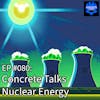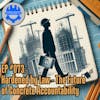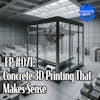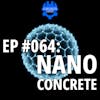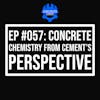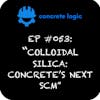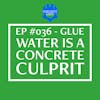EP #061: Capturing the Concrete Boogeyman
What is carbon capture? Why is CO2, the gas that we all exhale, considered a pollutant when it comes to producing concrete?
This Concrete Logic Podcast episode features a special guest, John Kline, a seasoned chemical engineer with a rich 50-year career in the cement industry. John has worn many hats, from research to project management, plant operations to optimization, and most recently, he has been focusing on reducing the carbon footprint of concrete by different means including carbon capture.
Join us to gain a deeper understanding of carbon capture and whether this technology truly has potential.
You will be surprised by John's perspective on carbon capture and what he believes is the answer to a sustainable future.
***
Did you learn something from this episode? If so, please consider donating to the show to help us continue to provide high-quality content for the concrete industry.
Donate here: https://www.concretelogicpodcast.com/support/
***
Episode References
Guest: John Kline | Kline Consulting | johnpkline1@gmail.com
Guest Website: https://www.linkedin.com/in/john-kline-18003010/
Producers: Jodi Tandett, Olivia Stocker, Patrick Bridgeman
Donate & Become a Producer: https://www.concretelogicpodcast.com/support/
Music: Mike Dunton | https://www.mikeduntonmusic.com | mikeduntonmusic@gmail.com | Instagram @Mike_Dunton
Host: Seth Tandett, seth@concretelogicpodcast.com
Host LinkedIn: https://www.linkedin.com/in/seth-tandett/
Website: https://www.concretelogicpodcast.com/
LinkedIn: https://www.linkedin.com/company/concrete-logic-podcast
Seth: And welcome to another episode of the Concrete Logic Podcast. And today I have John Klein. John, could you give an introduction about yourself and your company?
John Kline: Yep, so I'm a chemical engineer. I've spent 50 years in the cement industry, and I've done a little bit of just about everything from, I started off in research department at a cement equipment manufacturing company.
I've sold equipment. I've designed plants. I've been in project management. I've done projects in plants, operated plants. Optimized plants and most recently, since about 2008, been working on reducing the carbon footprint of concrete. So retired from Lafarge after 21 years with Lafarge, one of the international, large international cement companies had 18 years in international executive positions with them and retired in 2012.
I've been consulting since then. Working with large multinationals down to startups on three different areas primarily, but the most important reducing the carbon footprint of cement and concrete also been working on plant optimizations and then training of personnel. So I'll leave it there.
I could go on for a while. I'll leave it there.
Seth: I was searching for someone that could come on the show and give us an overview of carbon capture. And I reached out to a previous guest on the podcast, and they recommend you very highly. I guess you've been going around. I haven't had the privilege of jumping on one of your webinars, but I guess you've been doing webinars for this for a while.
So could you give us A basic overview of what carbon capture is, and then we'll I'll ask questions as we move along here.
John Kline: Well, and it's bigger than carbon capture. So the idea is to produce products without any emissions profile. And that can be done through many different methods. Carbon capture is one of them.
So, in the cement and concrete world, what we're looking for is a concrete product that is, has zero carbon emissions through the whole manufacturing process, starting with the pouring of the material, producing the cement. Producing the concrete and the majority of the CO2 emissions from concrete comes from the production of the Portland cement, which is the glue that holds the concrete together.
A lot of people do not say new to the industry. There's a lot of confusion between cement and concrete cement is a powder. It's a manufactured powder. That when mixed with water will react and harden. And then the concrete is the hardened product from that. So the sidewalk is concrete, or the building is concrete, not really cement.
So cement is the main focus for reducing the carbon footprint of concrete. Then, there's other elements in there, the transportation of materials to and from a concrete ready-mix plant. But, By far cement production because it requires a lot of heat, very high heats 2500 degrees Fahrenheit.
To produce the cement clinker, which is the main component in the cement, a lot of fuel is required. It uses lime as one of the main constituents in Portland cement. The lime comes from limestone, so limestone is calcium oxide plus CO2. So, calcium carbonate is limestone. In order to reactivate the limestone, we heat it up, drive off the CO2, and that's the major emission.
So, if we look at cement as the main piece in concrete, limestone is the main piece in cement, then there's the fuel that goes into it. We wouldn't typically think of that in the concrete perspective. We think of it in the cement perspective. And again, that's where the majority of the CO2 is released.
And then there's several different ways of doing that.
Seth: I will tell you; our audience is very aware of the difference between cement and concrete. We've had. Other episodes where we've done some deep dives at cement. And the reason for that cement is getting a lot of attention. These days is the big transition to type one L it's getting bad mouthed across the concrete industry.
Oh, we've had several episodes about that. And we actually had Peter Paone on the podcast, and he came up and gave us the cement perspective on what's going on. And it was very eye opening on what cement producers, what they go through to produce cement, the challenges they have. So my view, my personal view of cement production has changed quite a bit since that discussion with Peter and appreciating what the cement industry goes through to produce cement.
John Kline: Your listeners probably understand that concrete industry is the largest industry in the world. 20 to 25 billion tons a year of concrete being produced. That requires in excess of 4 billion tons of cement a year. And because cement has limestone in it, and it requires a high temperatures.
It generates around 7 percent of the manmade anthropogenic CO2 emissions. And that is why it's got such a big target on it. The move to limestone cement, it was good because before we get into carbon capture, maybe look at other mitigation techniques. So producing it more efficiently, using less material, using less electricity, using less fuel.
So, anything you can do to improve the efficiency, reduces the carbon footprint, the absolute biggest lever that the cement and concrete industry has, is to put in what we call a supplemental cementitious materials, so limestone being considered one of those. But really, it's fly ash ground granulated blast furnace slag are the two leading ones, natural pozzolans so volcanic ash.
Certain volcanic ashes are very good as a cement supplement. And calcined clay is another one we'll hear a lot about. So the idea is that you find something that operates well with cement, has similar properties to cement. And then you can put less cement in your concrete. So we call that SCMs or Supplemental Cementitious Materials.
Limestone is inert so it doesn't really qualify as a Supplemental Cementitious Material. Typically, it has to add some strength to the concrete. So, we know that For example, blast furnace slag, which is a byproduct of the iron producing industry, has a very similar chemistry to Portland cement, and if you grind that up, it was a waste product years ago, just landfill dump, and now we find if you cool that very quickly, you can preserve its chemical properties it's reactivity, I should say so we call that quenched we have air cooled slag, which is slowly cooled, which doesn't have any reactivity, and then we have the quenched slag.
Or granulated slag. So when you quench it very quickly, it kind of forms it looks like beach sand, like a coarse beach sand comes out in small crystals, and that reserve, preserves its reactivity. So that one is a very good cement substitute. The problem is there's only about 350 million tons produced a year.
So and, almost all of that today is going into concrete. So we've got being more efficient we've got using alternative fuels and alternative materials. So any material that has lime in it where the lime again, lime is without the CO2. Calcium carbonate limestone is with the CO2.
So we can get a raw material without CO2. That reduces it. And all of those, I call them the low hanging fruit. So you want to do as much as you can on that side. Another interesting development is using hydrogen fuel. So, if you use hydrogen fuel then you're not generating any carbon dioxide but it's a very quick reacting fuel.
So you need to be able to get it and not a lot of it available right now and be You'll have to modify the cement industry, you'll have to modify their processes to be able to utilize it. So, these are things that can be done before you get to carbon capture. Different organizations have different roadmaps.
Here's how we're going to get to carbon neutrality. roadmap.
And usually they say that 40, somewhere between 40 percent is going to have to actually be carbon capture. So carbon capture is, we're going to take the carbon that we produce, the CO2 that we produce, we're going to take that out of the emissions somehow, and then we're going to do something with it. So you have carbon capture and storage, which means I'm going to put it someplace.
And then we have carbon capture and utilization, which means I'm going to use that carbon somehow to hopefully make a product or do something with it. And then in that carbon capture space I would say the most prominent technology right now is using liquid sorbents. So, it's a chemical you bubble the gas through this chemical.
There tend to be liquids, it can also be solids, but you move the gas through, it traps the CO2, and then you do something to release the CO2, and it's typically done with a temperature swing. So you capture it cold, and then you heat up the liquid, and that releases the CO2 again, and then you can recycle the liquid.
And the most famous one you hear about is amine scrubbing and amine scrubbing it's been around for a long time, cleaning up like natural gas streams and things. I've been using it more for purification and for carbon capture, but it's a. Fairly well known technology it's, has its own issues there's, no super-duper answer out there so in the world of carbon capture the, you got what I call you have the pre process steps, so I'm gonna take the carbon out of the fuel, so if you're just using fuel, you didn't have the limestone, you can use hydrogen, that's taking the carbon out of the fuel.
That doesn't work as well in the cement industry because we have the CO2 from the limestone. But you can do indirect, what we call indirect calcination, so you heat that limestone up with green energy somehow, maybe electric induction, or maybe hydrogen combustion. You get a concentrated c o two stream we can do oxy combustion where we have the carbon, the c o two and the fuel, but we take all the nitrogen out of the combustion air.
So then with oxy combustion, which is one of the more amines I mentioned, the liquid absorbance is right now the most looked at technology, I would say in cement. After that, oxy fuel combustion seems to me to be number two, so you basically put in what we call an air separation unit. You take air from your plant, you take out the oxygen, separate the oxygen and the nitrogen.
Air is approximately 21 percent by volume oxygen, 79 percent nitrogen, a little bit of CO2 in it, a little bit of argon in it. It's primarily nitrogen, so if we take out the nitrogen, then we just have the oxygen. When we go through the process, we have a very concentrated CO2 stream with a little bit of water in it, and we can separate out the water, and then that CO2 is ready.
For compression and storage or compression and utilization. So, oxycombustion has been looked at. It's my opinion, it's more for a new plant construction, as opposed to being added on to an existing plant. Amine solutions, we call that a tailpipe solution, so you can put it on after everything else. So that can be done.
In any existing plants, new plants, and then we have well, there's a couple other technologies. I mentioned the sorbents could be solid. There's a couple solid sorbent. Test out there, they're not as well developed. There's nothing that's really ready for commercial on that side. There's cryogenic test separation.
So, in cryogenic separation, we take the gases from the cement plant. Super cool them down. There are different ways of doing it, but the, as you cool gases, there's different gases will turn to liquid at different temperatures. So you can do it by temperature differentiation, but also carbon dioxide.
pretty amazing, because it's got what they call the triple point. There's a point at which it could be liquid, gas, or solid. And just by changing a little bit the temperature or the pressure, you can go from any one of those states to the other state. So at least one interesting cryogenic capture technology is.
Taking it to a solid, separating the solid out from the liquid, reheating the liquid, that would be the oxygen, the nitrogen, any other gases, and they would go out the normal way, and then the CO2 would come out They would convert it back to a liquid. It would be ready for transportation for sequestration and utilization.
That's quite interesting, requires quite a bit of electricity. If it was green electricity, that would be a fairly green way to do it. And I think that one's interesting. Just about everybody's looked at algae, using algae microbes to capture CO2. So the idea is you would run the flue-gassed lakes of algae, and they would have to be lakes for a cement plant fairly large surface areas, or they're called photobioreactors, where you're running it through clear plastic tubes.
You have to get sunlight into the algae. It needs some nutrients, so typically you need to add some nitrates. But the problem with algae is to get a ton of algae costs about a thousand dollars between power and nutrients and everything. So if you're not, you can't make gasoline, it doesn't, at a thousand dollars a ton, it doesn't pay.
So you have to make a very high-end product. It could be a pharmaceutical, nutraceutical. I think you'll see algae projects being a niche kind of a thing going forward.
So we got oxy fuel, we did cryogenic. Another one that's interesting, particularly for the cement industry, is what they call carbonate looping. So I mentioned that limestone is calcium carbonate. We heat it up, we convert it to lime and CO2. Well, that process is reversible. So, if we cool the lime.
And put it back in the gas with cool CO2, it'll recombine to calcium carbonate. So it's not a very efficient process in that the lime when we're looking at different sorbents, I talked about, again, the amines, the liquid sorbent, the solid sorbent, we're looking for something that has a lot of turns, that you can use it 20, 30 times before it has to be discarded and you put in some new reactant.
Well, lime doesn't have that many turns. It's only my understanding, it's around four turns. So it's not very interesting for, say, a power plant. But in a cement plant, that lime can then become raw material. So it's very interesting, could be very interesting for a cement plant. There is a pilot unit operating in Italy.
It doesn't appear, even though a lot of work's been done on it, it doesn't appear to be that interesting as far as industrial projects go. So there's a bunch of technologies out there. There's more coming along all the time. A lot of the work is looking at... The existing technologies, like these, like I mentioned the liquid sorbent.
Can I make a more durable liquid sorbent? Can I make something that lasts, maybe not 20 turns, but 120 turns or 200 turns and if you can increase the life of the sorbent, then you can greatly reduce the cost of the carbon capture. On the utilization side, the most interesting projects are looking to go adding hydrogen to the captured carbon, making a natural gas type product, methane, ethanol would be another one that's being looked at, methanol.
So these are hydrocarbons some, the OL ones, the methanol, ethanol have Oh, I should say I'm a chemical engineer. I think it's a little too complicated. But anyway so there are some of these paths that can go to use. There's a couple of projects like that out there. So in, in in summary there's, quite a few technologies.
Now, where are we today? There is one plant there's a bunch of pilot plants out there.
Seth: Yeah, can I show you something? I've been poking around at this website. Let me show you this screen, see if I can make this work.
John Kline: If I knew it, I could have given you a slideshow.
Seth: Oh, no, we don't like slideshows here. Okay.
Let me see. Let me share that so this website. Do you know this website?
John Kline: I don't know if that's, is that the G C A? It looks like it.
Seth: Yeah. So this is the Green Cement technology tracker. And it's got all these pilot programs on here. Apparently, Europe's really busy with this stuff.
Yep. And there's only a few here in North America, but the one I think it was this one. One of these up in Canada that got my attention and that's when I reached out to Eric. And then he, led me to you. So which one of these?
John Kline: I have to be very careful. I don't want to disparage anybody, but there's a lot of greenwashing out there.
Seth: Oh, yeah, we know that. Yeah, no I, agree. In greenwashing, we mean, by their offsetting their whatever CO2s you're putting out by doing something else offsite. Is that what you mean by greenwashing?
John Kline: No, I mean they're claiming to be greener than they are.
Seth: Oh, yeah. Okay.
John Kline: So, on that map, let me go back, keep the map up.
Okay. There is one major project under construction today. One. And that's in Norway, and that should be running next year. It's probably that purple square dot up there, the Brevik project. Do the purple, square.
Seth: The purple square that says. Is that it?
John Kline: CPL and post combustion. No. Huh.
Interesting. Okay. I'll go. Anyway there is a project under construction in Norway. It's to capture 400, 000 tons a year. Looks like a very good project. It's like a liquid sorbent capture. And that CO2 is gonna be used for enhanced oil field recovery. It'll be liquefied, shipped by boat from Norway out to the North Sea.
And that'll be used for enhanced oil field recovery. So the enhanced oil field recovery, they put the CO2 into an oil field. It expands when it's in the oil field, and then it pushes out more oil. So you're doing two things. You're capturing the CO2. Anything that goes in the ground, in my opinion, is landfilling, but at least you're landfilling it and getting something for it.
Seth: don't they use CO2 already for drilling for oil?
John Kline: Well for, enhanced oil field recovery. Yes. All over. All over. It's been being done, I think, for 20 years. We used to use nitrogen, N2, because it was a little easier to get. But with CO2, they get some potential credits.
So, if we look at the North American map I talked about cryogenic. There's a 30 ton per day cryogenic unit being built in outside of Kansas City Missouri. Yeah, the sugar Creek. That's it. Okay. That's a 30 ton per day. That's being built. There's a 10 ton per day down in California. That's a 10 ton per day.
Cemex. Yeah. So those 2 are actually going to capture carbon. Everything else right now is a study. Yeah. So all of those other ones are studies. And then what is fairly advanced is the purple one, the farthest up in Canada. That one they finished their study. They've announced they're going ahead.
The government's kind of giving them a green light. But they haven't broken ground, and that will be when that is, if that is constructed according to their schedule, that will be the largest in a cement plant in the world if it's on schedule. So, a lot of these there's all kinds of issues out there still.
So if you think about it, you're in Richmond, Virginia. I'm gonna start pumping CO2 underneath your house because that's the best thing for that CO2. And if that CO2 came to the surface, well that could be a problem. What are you gonna do? So that's one of the one of the issues for sure.
Seth: So they don't, know any of the implications of storing this stuff for a long period of time?
John Kline: Well, I mentioned there's been 20 years’ experience in the oil fields, but the oil fields tend to be isolated. You don't have a housing development with oil wells around it.
Typically, so it's, there's quite a few questions on it. And who owns those big empty spaces underground if they go from state to state or country to country Whose space is it? Who's got the who's got the rights to that space? So there's a bunch of questions on that side.
There's a bunch of questions on the piping of it. The EPA has determined that CO2 is a pollutant. I don't think that's... I don't think that's fair. I think we need CO2 for life on Earth.
Seth: Yeah plants, like CO2.
John Kline: Yeah, yeah. So but then if you have a pipeline going through your neighborhood, they take the right of eminent domain, they run a line, pipeline through your backyard, how happy you're going to be.
It's for the good of humanity, but are so you got all these issues that, you know and then none of these things are perfect. Yeah. So I recently was hired by the Portland Cement Association to do a review of a report being put out by the U. S. Department of Energy on carbon capture.
And when I got finished reviewing this report, my, my takeaway was this doesn't seem to be as good as all the hype tends to indicate. So it would double the plant power consumption, it would double the plant fuel consumption, it would generate new waste streams that are not there today, it would you would have to burn fuel.
To make steam, to capture, to release the CO2 and you have your absorber where you're absorbing the CO2, then you heat it up again to release it. They call that the stripper. So then you release the CO2, and then we don't know enough yet about how the liquid the amines or whatever that absorbent is.
They tend to break down over time. I talked about the number of turns. Well, as they break down, they emit hydrocarbons into the atmosphere, some of which could be carcinogenic. So you have it's, very complex. It sounds so simple when people say just get green energy, CCUS. It's CCS. It's a very complex subject.
And again, if I take it to any individual, you say, hey, yeah, I'm all in favor of green, but do I want a pipeline in my backyard? Do I want to have it buried underneath me? Is it good if it's under a school or a hospital, is that a good thing? And we're early, we are in early days.
It's been 20 years, I think, since we've been putting it underground, but I think we're still in very early days. How many things have we looked at 100 years later and said, boy, that was dumb?
Seth: Yeah. Well I forgot, who the quote is, but a famous economist said, "there's no solutions that are only tradeoffs."
So what are we willing to trade off for this technology? And I think the things that you brought up that are gonna be issues with carbon capture. There's a lot of technologies out there. Even current fossil fuel use has the same issues, eminent domain issues and pipeline emissions and even expanding the electrical grid.
So we can charge all these new Battery powered cars, all those things have tradeoffs, and I don't think people have it. And like you said there's not a perfect solution out there.
John Kline: And no things will become clearer as we go down the path. And there are billions of dollars being poured into this every year in just in the cement industry alone.
And the concrete industry I know, maybe not so many changes being required, but just generating the environmental product declarations, the EPDs that's not inexpensive for a company. And now we see the law is changing where contracts are going to be awarded based on your EPD more importantly than on your cost.
So now the guy who has the lowest EPD well, that would be somebody who normally would have the least amount of cement in his concrete. We will get the job and then is that concrete going to last as long? Maybe hopefully but there's, a lot of, every now and then we see, like, good wishes taking us down bad roads and I, think it needs a holistic approach.
I, myself, I'm very optimistic. I I've looked at this for a long time. I've been working on it since 2008. And concrete is the lowest CO2 per unit weight of any material that we use in construction. So if you're saying I'm getting rid of concrete, well what are you going to replace it with?
Right now we don't have anything lower on the scale. People talk about geopolymers and all kinds of processes to generate no CO2 concrete. Thank you. Most of those processes require quite a bit more energy or other materials. And on the other hand I'm starting to change my tune to concrete.
My original when I started consulting, even before when I was still with Lafarge, we said cements not bad. It's just big. It's got a problem being big. It's a very concentrated industry. So you, you have maybe 2,400 up to 3,000 cement plants globally all around the world.
So, compared to a lot of other things, you look at automobiles. Are probably one of the or, transportation is probably one of the largest CO2 producers, but you got billions of vehicles around the world. So that's a little tougher than 2,400 and even the ready mix. If you look at ready mix plants, there's thousands and thousands of them versus, versus again, the cement plants in the US CO2 from cement in the US is less than 1 percent of the total emissions.
Yeah. I've seen lots of statistics, but a lot of them, the cherry-picked, but I won't say they're cherry picked. They're just incorrect, but it's around 1 percent or less than 1%. There's a lot of things that generate a lot more CO2 in the U. S. We have about 100 cement plants. We're consuming right now about 125 million tons of cement.
Of which roughly 25 million is imported from other countries. One of the concerns we're going to have is that, like Europe and California already when you start tightening up the CO2 with taxes or additional costs, then People start to look for lower cost cement, which some of these imported countries is coming from Turkey, from Algeria, from not so much from China, a lot from Vietnam.
Of course, we have a lot from Canada that one third of the Canadian cement production comes into the U. S. I'm a dual citizen, US Canadian. I don't wanna pick on my Canadian brethren, but the environmental requirements in Canada are much less stringent than they are in the us so, yeah, we're getting it from Canada.
It's not our CO2. But our cement is cleaner than a lot of this imported cement. So we've gone around a little bit. I don't know. Give me some direction.
Seth: Well, I think we're getting close to the end here. I think what you're getting at is there's some unintended consequences to like what you said, what California did and what Europe did when you tighten down the screws on what's required.
I don't even know how they're determining what's the bad level and a good level of CO2.
John Kline: Yeah, the way it's done in most places, they say either here's a benchmark, like, here's an industry average, or here's what you've done historically. Those are 2 things, and then they say, our program is that next year, you're going to reduce by 2%.
If you can't reduce by two percent, then you have to pay. You buy credits or pay a tax or something. And then you, so they start off, it's very painless at first, and then it's just the thumbscrew gets tightened a little bit every time. I do want to come back to my hopefulness because, so I've changed from cement being a victim of success just being big to concrete is the answer.
So I mentioned 25 billion tons of concrete, of which roughly 85%, 80, 85 percent is fill materials. Maybe you could say on high performance concrete, maybe it's 75%, so you have sand aggregate. All of that could be carbon-based materials. We could put a lot of carbon into concrete. So I, recently did a podcast where I talked about some of the things that are happening just to make concrete better, so graphene going into concrete carbon fiber going in as a replacement for steel even carbon rods going in instead of the iron bars and then you've got A lot of papers out there on using biochar, so the idea of biochar is you grow your fuel, whatever it is let's just say you're clearing, the dead wood from the forest you bring that in, you heat it without oxygen, you drive off the volatile material, the gases and oils you use that as a fuel, and then what's left is like charcoal, And that can be ground up and put into concrete and that would be permanently sequestered.
It would not, you wouldn't need a pipeline in your backyard. You wouldn't need that pool of CO2 sitting underneath your house so that would be, I think, a very good way of sequestering a lot of carbon and making concrete, not only carbon negative, but the preferred building material for a long time into the future.
So that's my, yeah. My new rant out there is concrete as the answer. It's not a problem. And we just have to now start filling in the bits and pieces that, to make that come to reality.
Seth: I like that approach. We'll have to bring you back on as you explore that avenue a little bit further and get your perspective on that.
John Kline: The other thing besides carbon, concrete can absorb a lot of waste materials. I've seen things where they're putting in waste plastic, chopped up windmill blades obviously recycled concrete can be recycled and go back in. So there. It can, because there's a lot of inert material in there.
I'm not saying you don't have to tweak it. I'm not saying it's easy, but there, there is a tremendous opportunity to use concrete as a solution to a lot of problems.
Seth: Yeah. Yeah. There's a lot out there. People are experimenting. I saw one, someone posted the other day, coffee grounds that, that's I think in Japan they were using discarded food or something, all kinds of organic stuff that I was like, oh, I don't know if I want organic things in my concrete. That doesn't say sound structurally sound.
But I like your approach that concrete is the answer. And I think you hit it on the head when you said we got to look at this holistically instead of trying to figure that silver bullet of things.
Cause my fear is like this carbon capture approach is it's, increasing the cost of concrete versus reducing the cost. So the things that make us more efficient, I think are beneficial for industry, not, increasing the cost of the of concrete. Cause we're trying to promote the use of concrete.
At the same time to reduce its impact on the planet. So things that we bolt on and make it more expensive to me is not ideal.
John Kline: My dream is that we have a life cycle assessment model for all building materials. That all the different, right now we throw stones at each other, so the concrete guys don't like the wood guys or the asphalt guys, and we pick our data to make them look bad, and they pick their data to make us look bad.
I'd like to see a model that basically everybody can agree, and it's going to tell us here is the best building material for this situation for humanity and forget all the. All the lobby groups or whatever, the lobbyists who are pushing their particular solution I, I've looked at I've done a study on making wood pellets and shipping them to the UK so they can have green, power generation and it's crazy.
And people think wood is very green. Well, it's green when you start, but you got to chop it down, you got to haul it someplace, you got to cut it up, you got to kiln dry it then you got to package it, take it to there's a lot of transportation, by the time you look at all the various steps, and then you look at how much time it really requires to, regrow that.
It's not nearly as green as it looks, and some studies will tell you it's worse than concrete. So we, we've got all these kind of images in our mind that are not necessarily true such as your map with all the dots on it. Yeah, they're all projects. They're also but most of them are in the study phase.
Very few of them are very few of them have broken ground.
Seth: Yeah, I think we're, going through a phase right now where the green push on the forefront and we'll see how long this Trend last, and we lose focus on it again.
John Kline: Regardless of what you think about CO2 and the environment, improving efficiency every step of the way is always a good thing.
And I think it's really is twisting our arm a little bit to really explore some of these in limestone cement, it's a learning curve and it can be a painful learning curve. It's been used limestone cement was used, 25 percent in Europe for 2030 years. It's a learning curve and I'm sure from the concrete ready mix side, it's a pain because every single mixed design has got to be redone and you got to do, I don't know how many billion, millions, whatever test you got to do to make sure that you're not, Shorting your customers and the that your mixes are going to meet the requirements.
Not easy. And in the end what's going to happen is the quantity of cement into concrete is going to go down. So the people who are going to be hurt the most are the actual cement producers. I think the concrete's not going to go away.
No, everybody. Everybody's focused on the cement.
Nobody's you get the cement out of concrete. Everybody be happy.
Seth: Yeah. Well, 1st for a time and then they'll figure something else to pick on it. But I think this is a good spot for us to end today. John, I really appreciate you coming on the show, and if folks wanna reach out to you and learn more about what you're doing and wanna work with you, what's the best way to get ahold of you?
John Kline: Tell them to gimme a call 484-602-3474. I didn't have a slide prepared.
Seth: No, no slides needed. When we put this out, we'll post your contact information and you're you got a lot of followers on LinkedIn too. So I'll make sure people check you out on LinkedIn as well.
John Kline: And I usually if I'm doing some training or doing a presentation, I didn't advertise this one. I wasn't quite sure if we were programming today or talking about programming today. But usually I'll put a message out on LinkedIn if I'm going to be doing a. A presentation I just did three a couple weeks ago in Panama for Spanish and Portuguese speaking groups.
Seth: Yeah. And you did one in Europe recently as well.
John Kline: On concrete.
Seth: Yeah. All right, John. I appreciate you coming on the show, and we'll have to do this again.
John Kline: It was my pleasure.










